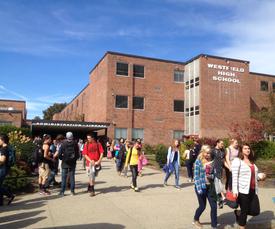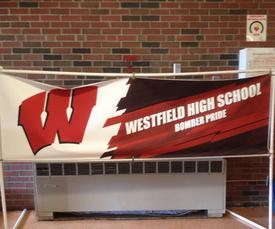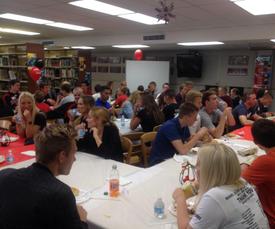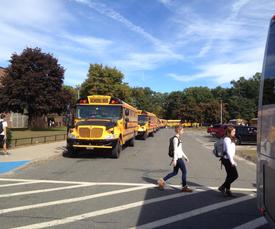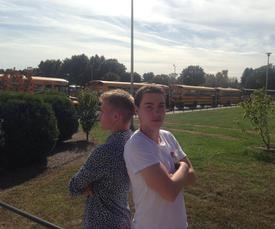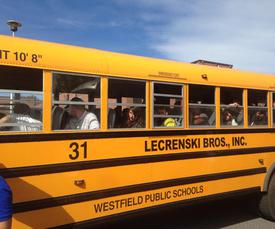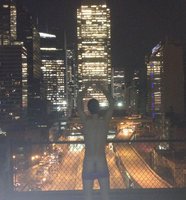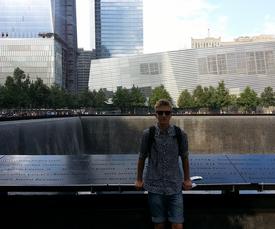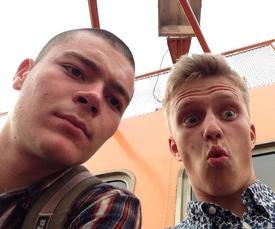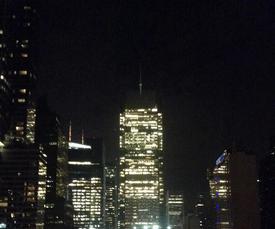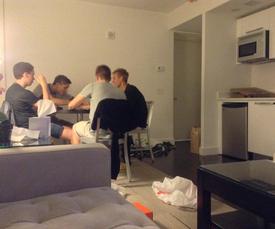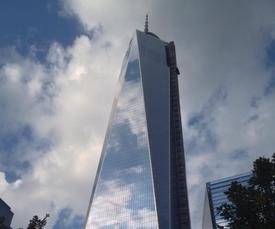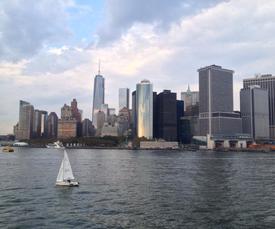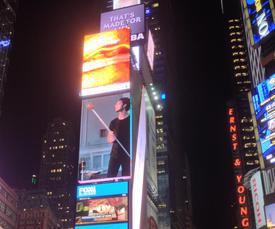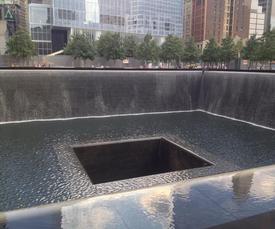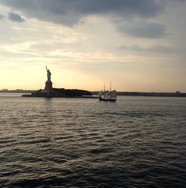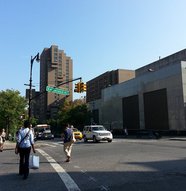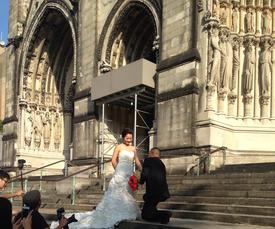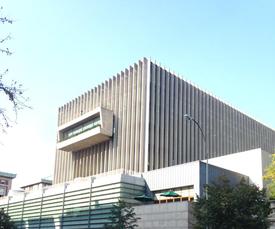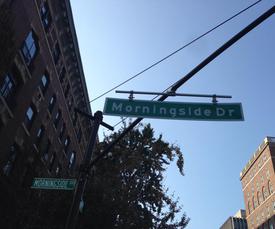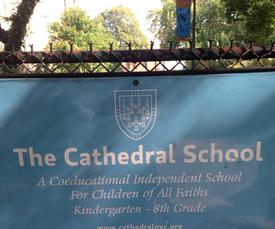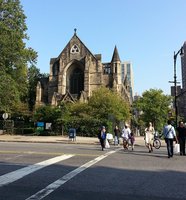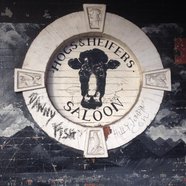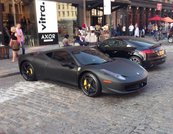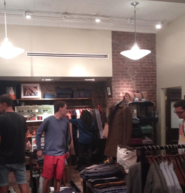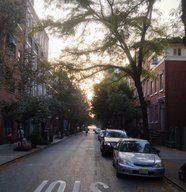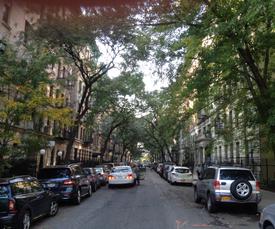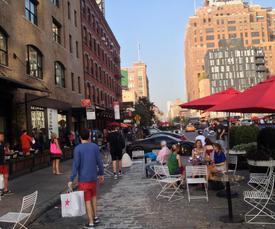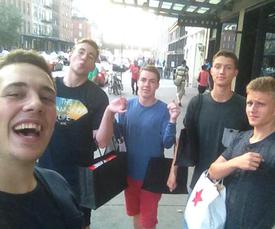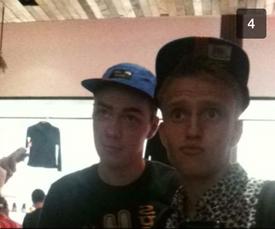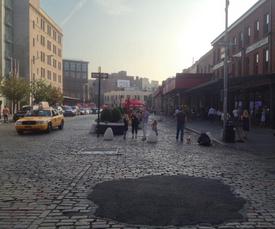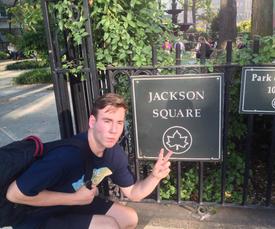
The
Adventurous
Danes
FOLLOW US ON FACEBOOK
Today's Golden Words |
1. Shutdown can't stop us |
2. Johannes V. Langkilde is awesome! |
3. Mahatma gave us an interesting lesson on racism in America today |
4. Can't find no ***damn Chipotle :( |
5. Now: The Bowling Danes |
6. We would pay one hundred dollar for a single beer right now... |
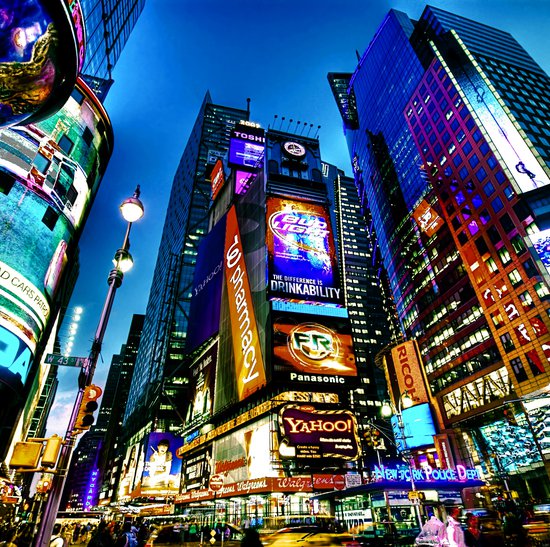
NYC - Manhattan
We were excited to go to the most famous city in the United States. NYC consist of five boroughs which all together consists of a population of 8 million people! Eight million people, can you believe that? Almost three million people more than there is in all of Denmark. No wonder that NYC is the center of attention when it comes to commerce, finance, media, art, fashion, research, technology, education, and entertainment. The ethnic diversity in this city is probably higher than in any other American city. It's for sure that we have to keep that in mind when we interview people in the different districts. We only travel in North-Eastern states and we won't get to see the Southern states where people seem to have stronger prejudices against Black people etc. We only get to see a small part of the picture.
Westfield High School - "A bunch of Danish and American kids getting along"
Before we arrived at our apartments in New York, we visited Westfield High School. The students at Westfield High are very much like us. Why wouldn't they be? In the end they are normal young people like us. The only thing that makes them different is the school system. The high school system in Denmark (slightly depending on which school we are talking about) is very liberal compared to the American high schools. As Danish students we see the American school system as very strict. You call the teacher by his/hers lastname, you need a hall pass to walk freely on the halls, the teachers are very strict. Furthermore, cellphones were prohibited in the library and in most of the school areas. All in all the American students envied us when we told them about the freedom we have during school time. But remember, with freedom comes great responsibility. In addition to freedom, we do not have to pay for our education and we actually get payed for taking an education (SU).
One can talk about the strictness in the American schools, yet you can't complain about the students' school spirit, which in our school is close to non-existent. People often attend to sportgames to support their team. That kind of events are rarely seen at our school... or it's rarely seen that students attend to these events. In the end the American highschool was very similar to the schools you see in the movies, but the students were very kind and friendly to us. The Adventurous Danes agree on this: Westfield High School has been approved.
The city that never sleeps
NYC - The urban jungle
Kids look away. Our friend and fellow member of The Adventurous Danes, Louis, couldn't help it. New York has this intense essence of speed and action that makes you want to go wild. Apart from our butt naked friend, we had this amazing view from our apartment's roof. Furthermore, we only had a 2 minute walk to Time Square and 5th avenue. It was truly amazing. What plans did we have for the next two days? Shopping, eating, shopping, explore, shopping and shopping. Wherever we went on Manhattan there were great opportunities to eat and shop.We had been to Boston for a couple of days and witnessed a lot of historical landmarks. In NYC it was time for fun.
The most relevant question to ask concerning our experience of Manhattan would be, what surprised us the most about the place? First of all we can say that a couple of us have been to NYC once or twice before. Yet none of us had been to SoHo, the Meatpacking District or East Village and "wow", the difference between these downtown areas and the more financial embossed uptown is huge! When we took the subway to SoHo and came up from subsurface, we stepped into another world. The people here wore cool clothes and hipster-like clothes. Most of these people were young and actually looked like they cared about how their clothes affected their appearence. SoHo reminded us a lot of the inner city of Copenhagen. There were a lot of trendy boutiques with fancy dressed staff. The cool and fancy kids of NYC definately belong to downtown Manhattan.
We even got to experience East Village during friday night! Friday was the last night we had in NYC so we decided to eat at a cool place. We had been told that East Village was the place to go if you are young and want to have fun with others in bars and clubs. So we did. Well, we didn't go to bars or clubs due to the fact that we are too young to drink and buy alcohol according to American law, but we went there to find a place to eat. When we got to East Village, the place was crowded with boys and girls who was on their way to the bars and clubs. The atmosphere was electric. Sadly we could not join them, so after a joint walk in the crowded streets, we went home to our apartments to prepare for Washington DC.
...And no. We didn't spend ALL our time on shopping and in restaurants. We did see Ground Zero and we took the ferry to Staten Island to get a view of the Statue of Liberty. One morning we actually ran in Central Park. We would like to comment on our experience of Ground Zero. It's like a little shining pearl placed in the middle of a big hectic city. There is a lot of small green trees and every person is quite and respectful. Respectful to those who fell that day and to those who lives to suffer. In addition to this, we were proud of the newly build Freedom Tower. What proves the strenght of the western values more than placing an even bigger tower called "Freedom" on top of the place where terrorist tore down the Twin Towers to prove our values wrong. Freedom Tower tells them, that where they try to destroy everything we stand for, we rise again, stronger and more faithful to our values and beliefs.
Neighborhood Analysis and Interviews
Morningside Heights, Meatpacking District and Greenwich Village
Morningside Heights
Finally we arrived to our first destination on our schedule for the quarter analysis in the great city of New York. We took the subway from Times Square to 116 st. on Broadway right next to the famous Columbia University. When we came out of the metro we were met with a big surprise and asked ourselves, where are skyscrapers? Where are all the big electronic billboards? The buildings were so small compared to the center of Manhattan but they were still very beautiful considering that they weren’t architecturally modern, like all the skyscrapers in the uptown financial districts of Manhattan. Still, the Adventurous Danes were ready to take on Morningside Heights. Morningside Heights is a neighborhood of the borough of Manhattan in New York City. The total population of Morningside Heights is 211.678 thousand people and the middle age is 36 years. This means that Morningside Heights is a very common family neighborhood. Morningside Heights is known as the home of various institutions, especially educationally institutions such as Columbia University, Cathedral of Saint John the Divine, the private Barnard College which specializes in only women’s liberal arts, Jewish Theological Seminary of America and many more. The nickname of Morningside Heights is the Academic Acropolis due to all the educationally opportunities. In addition, the most common education in Morningside Heights among the population is a graduate degree (42,9% of the population) and a bachelor degree (32,4% of the population). Also, the employment numbers of Morningside Heights show that there are 83% white collar employees and 16% blue collar employees. White collar employees consist mostly of office workers who performs professional, managerial, or administrative work and blue collar employees consist mostly of unskilled or skilled workers who perform construction, mechanical, maintenance, technical installation and many other types of physical work. This means that the average person in Morningside Heights is highly educated and very wealthy. Before we arrived to this very educational district we expected a district much like Harlem. But it was nothing like that at all.
Morningside Heights is a part of the upper west side in New York City. Yet, is has been described by many people as part of “Greater Harlem”. “Greater Harlem” is an expression of the district of Harlem and the ones close to it are in a transition. Both central Harlem and “Greater Harlem” still have a strong black population majority. However, the population of both Central Harlem and “Greater Harlem” is shifting. Black people are starting to move out and other minorities including white people are starting to move into Greater Harem and Central Harlem. This is illustrated in the graphics below from The New York Times.
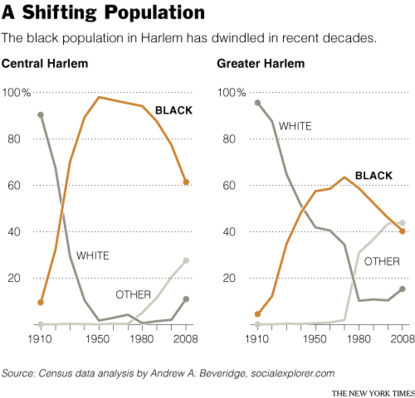
Morningside Heights Gallery
Statistic - Morningside Heights /100K
Violent crime Property crime Total crime index
466 (estimated) 1,278 (estimated) 1,744 (estimated)
At Morningside Heights we met a man, probably in his late 40’s, named David. David lived in Morningside Heights with a occupation that we do not know of. He wouldn’t let us video record him or take any photos of him. Therefore, sadly, we don’t have any film or photo for this interview. However, we recorded his voice with our phones and David told us his opinion on racism in the US. We asked him about whether or not racism was a big issue in the US and he answered this: “People are trying to perpetuate the myth of there is racism. When, most people are not racist. They interpret things aren’t there.”
David, one of the few people, who didn’t think that racism was an issue in the US at all. Afterwards he elaborated his opinion when we asked about if there were any signs of racism in Morningside Heights,
- “This area is mostly Colombia this is a bubble so this different area. I don’t think there is much racism… I don’t think there is racism at all in America. I just think it has been made into a bigger deal by special interests groups. Here i am talking about the leaders of the minorities in the society. The leaders are looking to perpetuate their own power by telling the minorities that you’re not getting your share, rather than telling them the reason you’re not getting your share is because you have broken families and you don’t study hard and you don’t take care of your children so that you can move on to the next generation. Look for example on the chinese and the japanese who America fought in the War. After one generation they own grocery stores the own businesses. They are able to get by. People come here from all over the world but it depends on your work ethic and your cultural ethic.”
David is basically telling us, that racism is an illusion created by the leaders of the minorities, to make it easier for the average black man to ignore the fact that he hasn't worked hard enough to get to a better position in life. It's an excusion to avoid the merciless truth, David says. He mentions the other minorities like the japanese or chinese who make a living for themselves after one generation.
To conclude on our trip to Morningside Heights we can say this. We brought a lot of stereotypes to Morningside Heights due to the fact that it is located right beside Harlem. We expected Morningside Heights to be a place where you don’t stay for much a long. Yet, we experienced the completely opposite. Morningside Heights is a place to stay. With the great opportunities of getting a prestigious education, it is one of the safest places to live on Manhattan. Maybe one day, the Adventures Danes will once again set their foot on the grounds of the Academic Acropolis - only time can tell.
Meatpacking District
It was late in the day, and after a long day we just wanted to go home and relax. The district which we were going to visit was the Meatpacking District. Our expectations were low due to its name. We expected an industrial district, consisting of factories and a low social class. However, what we found was the completely opposite. The Meatpacking District combines, the rough, old, industrial building of New York which dates all the way back to the industrialization and the new, fashionable retail stores, bars, clubs, restaurants and outlets. If you had to compare it to something in Denmark it would be “Kødbyen” because it’s quite similar in style and atmosphere.
In the early 1900s the Meatpacking District consisted of numerous slaughterhouses and meat markets. nowadays only around 5 slaughterhouses have survived. However in the 1990s several young designers and artists moved to the area and opened boutiques for the fashionable, around the same time, club owners saw the potential of this district and restored the old factories and turned them into trendy clubs. This active culture scene contributed this area to become a residential hotspot. The average price of an apartment in this area is 1.8 million dollars which underlines that it is a place for the wealthy.
The meatpacking district contains many public spaces, among them is a public park which is located on an abandoned elevated railway track. The park has big open green areas and an astonishing view of the area. we walked on top of these tracks and were fascinated of the contrast between the old and the new buildings. We looked down from the paved pathways of the old railroad and saw all these young fashionable people, walking around, shopping and there were even some sort of club hosting a fashion show down there. One thing struck us, there was almost no representatives of other races then the caucasian. This also relate to an interview we had done earlier with a teenager named Sarah. She told us the following about the district, “(...) in this district there is not a lot of racism, but it’s not really diverse either, there is pretty much only whites here. I don’t really interact with black people, but it is not by choice.”. We asked her the following, “why do you think there is almost only whites here?” and she answered, “ There is still a big difference between the rich and the poor, and sadly blacks are almost always poor, that might be the reason why you don’t see many blacks here. This might actually also be the reason why some people are racist, if they don’t interact with other races, they’ll only see the stereotypical races that the media might portray.” This confirmed our train of thoughts, the area was quite segregated, and the people here didn’t really associate with other races. Even though we didn't find a single person saying they had any stereotypes about other races or looked down upon them, it was clear that this would be an area where prejudice could easily blossom. Why hadn’t it? Well the area as we said early is upper middle class with a highly educated population, which might have an effect on the individuelles racial beliefs.
We came to the district expecting to take a few pictures interview three people as fast as possible and get on with our day. This wasn’t what happened. We ended up spending hours strolling the streets, discovering new and trendy stores all over, each one better than the one before. All in all this was really one of our favourite districts on the entire trip.
Greenwich Village
The next stop on our list, was Greenwich Village. ‘’The village’’, as referred to by local citizens, is a an old bohemian neighbourhood, who used to posses New Yorks majority of artists and creative minds. Today, as a result of expensive estate prices due to an increased demand, the cultural majority is now found in Soho and East Village. However, Greenwich Village remains to be a cultural hotspot, but also an attractive choice for the wealthy looking for a highly demanded address on Manhattan. The unemployment rate is half the unemployment rate in New York as a whole, in addition to that, people averagely have twice the income when compared to a normal New Yorker. It’s obvious, both as we walked around the neighbourhood observing the environment, and through statistics that the hippie stereotype slowly vanishes, as the exclusiveness makes it’s way through the streets of The village.
We had been walking around for several hours in Morningside and Meatpacking District, it was getting late and our feet were sore. Coming from the trendy, pulsating Meatpacking District, the atmosphere immediately seemed more calm and relaxed - a lovely break from the otherwise hasty and noisy Manhattan, full of honking cars, tourists and stressed out businessman. The buildings were smaller and more european compared to the other districts we visited along the way, so were the shops - neatly integrated with the residential areas. These small shops offered a variety of goods, ranging from internationally exclusive brands to local businesses still trying make it on the big scene, offering goods of high quality and fashionable sense. Especially one of these shops caught the eyes of The Adventurous Danes, and we immediately went inside to see it.
At some point we got lost in The village. To our luck, we stumbled into an older gentleman who were able to assist us. The gentleman's name was Mark, a citizen in Greenwich Village who had been living there long enough to experience the development who had taken place through the last decade. Mark was a developer for a big website, with around active 150.000 users. As we thanked him and he started to walk away, we realised that he would be a perfect interview for the District analysis, and our focus on racism, so we stopped him, and fortunately he agreed to participate.
Interview Mark
When we asked Mark about racism as a whole in America, he believed that racism relied on regionalism, in other words, racism depending on which location in America you are in. "In the northeast there’s a lot of prejudice against jews, and in the south - Texas, there’s a lot of prejudice against mexicans. In Mississippi or Alabama there is prejudice against blacks. So it depends on the region of the country you’re in." (qt. Mark). When we mentioned Greenwich itself, Mark agreed that the multiculturalism helped against racism, and he believed that the artistic spirit of the village was a part of the reason why racism was no real issue in the area. But he also stated that regionalism in terms of racism, was a part of NYC itself. "There’s regionalism in NYC itself, so if you go Harlem, if you go to some areas of Queens, Bronx, Brooklyn, there is prejudice against specific types of different areas." (qt. Mark).
Mark had been traveling to Europe several times, and therefore it seemed relevant for us ask him about a comparison between racism in America and Europe. Mark compared the highly visible racism in America, with facism in football games in Europe, as another way for the people to express an otherwise less visible racism. In addition to that, he later stated that some kind of regionalism would always exist, due to the fact that class struggle would always be an issue, with some people being at the lowest social ranks.
Meatpacking District and Greenwich Village Gallery
Copyright © All Rights Reserved
